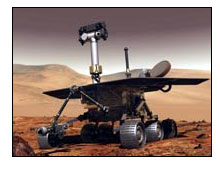PASADENA, Calif., Dec. 31 -- NASA's Spirit rover spacecraft fired its thrusters for 3.4 seconds on Dec. 26, to make a slight and possibly final correction in its flight path about a week before landing on Mars.
Radio tracking of the spacecraft during the 24 hours after the maneuver showed it to be right on course for its landing inside Mars' Gusev Crater on Jan. 4, NASA said. Spirit's twin, Opportunity, will reach Mars three weeks later and will land on the other side of the planet.

ROBOTIC FIELD GEOLOGIST: Artist's concept of Mars exploration rover (NASA)
"The maneuver went flawlessly," said Mark Adler, Spirit mission manager at NASA's Jet Propulsion Laboratory, in Pasadena, Calif. "Right now, it looks as though we hit the bull's-eye."
The rovers, working as robotic field geologists, will examine the sites for clues about what happened there. In particular, they will seek evidence about the local history of liquid water, key information for assessing whether the sites could ever have been hospitable to life.
"The clues are in the rocks, but you can't go to every rock, so you split the job into two pieces," said Steve Squyres, of Cornell University, principal investigator for the package of science instruments on the rovers.
The six-wheeled rovers can watch for hazards and maneuver around them. Each is equipped with a panoramic camera at human-eye height and a miniature thermal emission spectrometer with infrared vision to help scientists identify the most interesting rocks. The rovers use solar panels about the size of a kitchen table for power.
During the mission, a rover will drive to a selected rock and extend an arm with tools on the end. A microscopic imager, like a geologist's hand lens, will give a close-up view of the rock's texture. Two spectrometers will identify the composition of the rock, and another tool substitutes for a geologist's hammer, exposing the fresh interior of a rock by scraping away the weathered surface layer. The rovers are also outfitted with computers that will process and send data back to earth.
For both rovers approaching Mars, NASA said, the most daunting challenges will be descending through Mars' atmosphere, landing on the surface and opening up properly from the enclosed and folded configuration in which the rovers arrive. Most previous Mars landing attempts, by various nations, have failed.
For more information, visit: marsrovers.jpl.nasa.gov